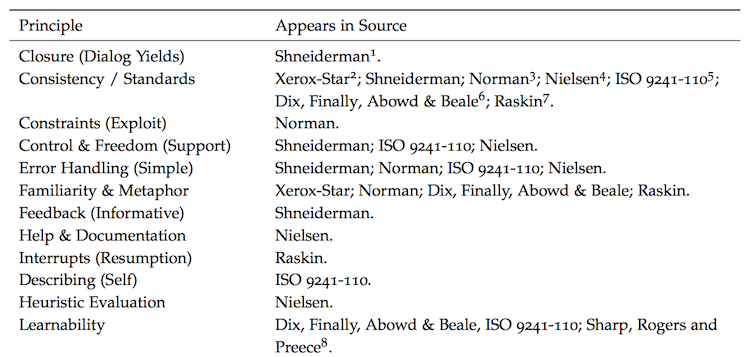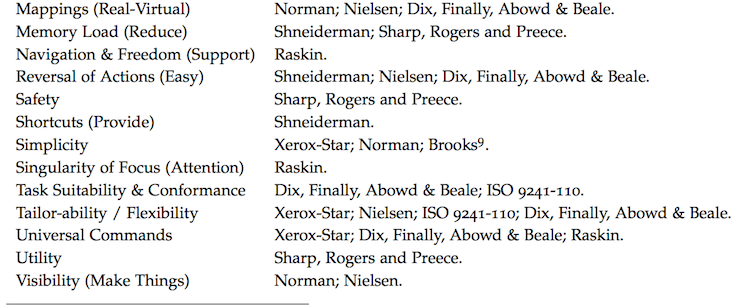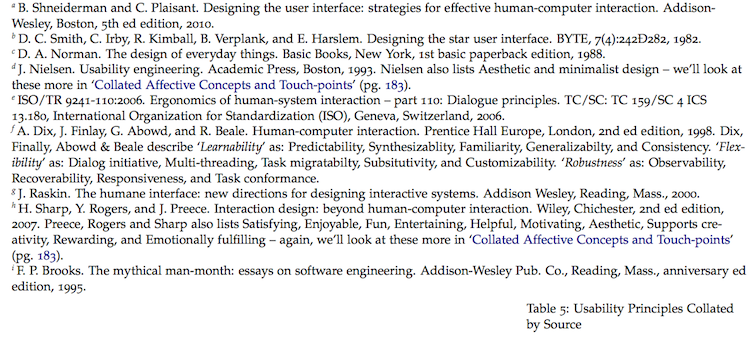class: centre, middle, inverse name: UX from 30,000ft specific: COMP33511 topic: Principles of Efficient Experience # {{name}}: {{topic}} ### Lecture 10 (50 minutes) ### [@sharpic](http://twitter.com/sharpic) .controls[[SAQ](saqs.html) [D](discuss.html) [OH](oh.html) [C](coffee.html) [P](coffee.html#2) [SLIDES](http://sharpic.github.io/COMP33511/#slides) [↩](#)] --- layout: true class: left, middle name: UX from 30,000ft noteid: Ch 06 - Efficient Experience (part 2) specific: COMP33511 website: http://sharpic.github.io/COMP33511 author: [@sharpic](http://twitter.com/sharpic) --- class: middle, center topic: Collated Principles .noteids[{{noteid}}] .credits[ {{author}} | UX from 30,000ft | {{specific}} | {{topic}}] .controls[[SAQ](saqs.html) [D](discuss.html) [OH](oh.html) [C](coffee.html) [P](coffee.html#2) [SLIDES](http://sharpic.github.io/COMP33511/#slides) [↩](#)] ## {{topic}} .tab[ .caption[Collated Usability Principles, Guidelines, and Rules .credit[Harper 2014]]] --- class: middle, center topic: Collated Principles .noteids[{{noteid}}] .credits[ {{author}} | UX from 30,000ft | {{specific}} | {{topic}}] .controls[[SAQ](saqs.html) [D](discuss.html) [OH](oh.html) [C](coffee.html) [P](coffee.html#2) [SLIDES](http://sharpic.github.io/COMP33511/#slides) [↩](#)] ## {{topic}} .tab[ .caption[Collated Usability Principles, Guidelines, and Rules .credit[Harper 2014]]] --- class: middle, center topic: Collated Principles .noteids[{{noteid}}] .credits[ {{author}} | UX from 30,000ft | {{specific}} | {{topic}}] .controls[[SAQ](saqs.html) [D](discuss.html) [OH](oh.html) [C](coffee.html) [P](coffee.html#2) [SLIDES](http://sharpic.github.io/COMP33511/#slides) [↩](#)] ## {{topic}} .tab[ .caption[Collated Usability Principles, Guidelines, and Rules .credit[Harper 2014]]] --- class: middle topic: Collated Principles .noteids[{{noteid}}] .credits[ {{author}} | UX from 30,000ft | {{specific}} | {{topic}}] .controls[[SAQ](saqs.html) [D](discuss.html) [OH](oh.html) [C](coffee.html) [P](coffee.html#2) [SLIDES](http://sharpic.github.io/COMP33511/#slides) [↩](#)] - '**Stability'** Are the interactions stable? - '**Scalability'** Does the interface and its data scale? - '**Simplicity'** Is interface and interaction simplicity encouraged? - 'Situational **Awareness**' Is perception of the interface facilitate decision making? - 'Self-**Description**' Does your system describe itself to the user? - 'Progressive **Disclosure**' Are the interface options presented a step at a time? -- - '**Familiarity**' Is your system us 'intuitive'? - '**Learnability**' Are the interactions easy to learn? - '**Consistency'** Does your system exhibit internal and external (OS) constancy? - '**Robustness**' Is the system robust to errors? -- ### SSSADD FLCR ☺ --- class: middle topic: Interaction Stability .noteids[{{noteid}}] .credits[ {{author}} | UX from 30,000ft | {{specific}} | {{topic}}] .controls[[SAQ](saqs.html) [D](discuss.html) [OH](oh.html) [C](coffee.html) [P](coffee.html#2) [SLIDES](http://sharpic.github.io/COMP33511/#slides) [↩](#)] ## {{topic}} ### Questions to think about as you design your prototype: -- 1. Are you able to resume interrupted actions? 1. Are you able easily reverse an action, incorrectly taken? 1. Are you able to understand your location in the interaction? 1. Does your system recover well from an unexpected event? 1. Does your interactions (including dialogs) exhibit stable non-cyclical behaviour and closure? --- class: middle topic: Facilitate Scalability .noteids[{{noteid}}] .credits[ {{author}} | UX from 30,000ft | {{specific}} | {{topic}}] .controls[[SAQ](saqs.html) [D](discuss.html) [OH](oh.html) [C](coffee.html) [P](coffee.html#2) [SLIDES](http://sharpic.github.io/COMP33511/#slides) [↩](#)] ## {{topic}} ### Questions to think about as you design your prototype: -- 1. Does your interface scale to handle larger datasets then envisaged etc? 1. Does your system handle data and interaction within an acceptable time? 1. Do complex actions scale up in terms of data and user requirements? 1. Do your interfaces remain simple when information is being dynamically added? 1. Can new functionality be added to your system without negatively impacting on its current interactions and interfaces? --- class: middle topic: Facilitate Simplicity .noteids[{{noteid}}] .credits[ {{author}} | UX from 30,000ft | {{specific}} | {{topic}}] .controls[[SAQ](saqs.html) [D](discuss.html) [OH](oh.html) [C](coffee.html) [P](coffee.html#2) [SLIDES](http://sharpic.github.io/COMP33511/#slides) [↩](#)] ## {{topic}} ### Questions to think about as you design your prototype: -- 1. Is your system presented simply? 1. Are the interactive elements simple to understand and use? 1. Can you understand the system behaviour without recourse to manuals of help systems? 1. Does your system exploit natural interactive constrains? 1. Is complexity hidden from the novice user? --- class: middle topic: Facilitate Situational Awareness .noteids[{{noteid}}] .credits[ {{author}} | UX from 30,000ft | {{specific}} | {{topic}}] .controls[[SAQ](saqs.html) [D](discuss.html) [OH](oh.html) [C](coffee.html) [P](coffee.html#2) [SLIDES](http://sharpic.github.io/COMP33511/#slides) [↩](#)] ## {{topic}} ### Questions to think about as you design your prototype: -- 1. Does your system facilitate orientation both within the interface and within the interaction? 1. Is orientation and navigation, around and through the interface (and interaction), easy? 1. Is error handling simple? Is feedback informative? 1. Are all components, needed for the interaction, visible? 1. Do you maintain a single focus of interactive attention, without distractors? --- class: middle topic: Facilitate Self-Description .noteids[{{noteid}}] .credits[ {{author}} | UX from 30,000ft | {{specific}} | {{topic}}] .controls[[SAQ](saqs.html) [D](discuss.html) [OH](oh.html) [C](coffee.html) [P](coffee.html#2) [SLIDES](http://sharpic.github.io/COMP33511/#slides) [↩](#)] ## {{topic}} ### Questions to think about as you design your prototype: -- 1. Is your system well documented? 1. Is help present and informative? 1. Is it possible to understand the program functionality without recourse to the manual? 1. Is it possible to understand the interface, widgets, and interactivity without recourse to the manual? 1. Is it possible to fully understand all dialogs, messages, and status'? --- class: middle topic: Facilitate Progressive Disclosure .noteids[{{noteid}}] .credits[ {{author}} | UX from 30,000ft | {{specific}} | {{topic}}] .controls[[SAQ](saqs.html) [D](discuss.html) [OH](oh.html) [C](coffee.html) [P](coffee.html#2) [SLIDES](http://sharpic.github.io/COMP33511/#slides) [↩](#)] ## {{topic}} ### Questions to think about as you design your prototype: -- 1. Does your interface look overly complex? If so, simplify. 1. Are there a lot of components displayed at one time? If so clean it. 1. Are there a multitude of possible actions available to the user? If so focus on building one action for one interface element. 1. Is there a tight logical hierarchy of actions? 1. Is the user led along the interactive path? --- class: middle topic: Facilitate Familiarity .noteids[{{noteid}}] .credits[ {{author}} | UX from 30,000ft | {{specific}} | {{topic}}] .controls[[SAQ](saqs.html) [D](discuss.html) [OH](oh.html) [C](coffee.html) [P](coffee.html#2) [SLIDES](http://sharpic.github.io/COMP33511/#slides) [↩](#)] ## {{topic}} ### Questions to think about as you design your prototype: -- 1. Does your system map real world concepts to the virtual world? 1. Does your system use terms the user is familiar with (including Jargon)? 1. Does the system work in familiar ways, with reference to itself and other comparable applications? 1. Do you assuage `intuition' for familiarity? 1. Does your system use easily understandable (and therefore familiar) messages? --- class: middle topic: Facilitate Learnability .noteids[{{noteid}}] .credits[ {{author}} | UX from 30,000ft | {{specific}} | {{topic}}] .controls[[SAQ](saqs.html) [D](discuss.html) [OH](oh.html) [C](coffee.html) [P](coffee.html#2) [SLIDES](http://sharpic.github.io/COMP33511/#slides) [↩](#)] ## {{topic}} ### Questions to think about as you design your prototype: -- 1. Is your system behaviour predictable? 1. Can users easily transit from novice to expert? 1. Can you understand the system behaviour without recourse to manuals of help systems? 1. How easy is it to learn any bespoke system functionality? 1. Does your system facilitate self learning, and functionality investigation? --- class: middle topic: Facilitate Consistency .noteids[{{noteid}}] .credits[ {{author}} | UX from 30,000ft | {{specific}} | {{topic}}] .controls[[SAQ](saqs.html) [D](discuss.html) [OH](oh.html) [C](coffee.html) [P](coffee.html#2) [SLIDES](http://sharpic.github.io/COMP33511/#slides) [↩](#)] ## {{topic}} ### Questions to think about as you design your prototype: -- 1. Am my developing a consistent interface? 1. Are the interactions consistent across the platform and development? 1. Is my command and event structure universal across the development and platform? 1. Am I following standards and best practice? 1. Am I following the platform design guide? --- class: middle topic: Facilitate Robustness .noteids[{{noteid}}] .credits[ {{author}} | UX from 30,000ft | {{specific}} | {{topic}}] .controls[[SAQ](saqs.html) [D](discuss.html) [OH](oh.html) [C](coffee.html) [P](coffee.html#2) [SLIDES](http://sharpic.github.io/COMP33511/#slides) [↩](#)] ## {{topic}} ### Questions to think about as you design your prototype: -- 1. Does your system recover well from an unexpected event? 1. Are errors easily dealt with? 1. Are incorrect user actions easily recoverable? 1. Is the user-state saved between sessions in the event of a system failure? 1. How does your system handle abnormal input?